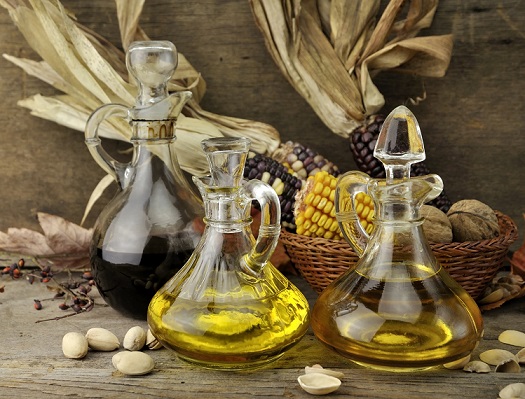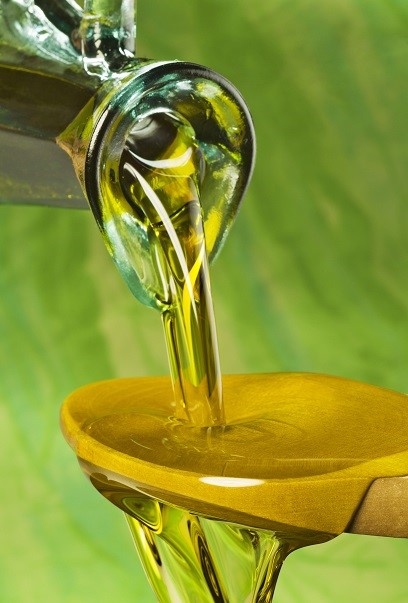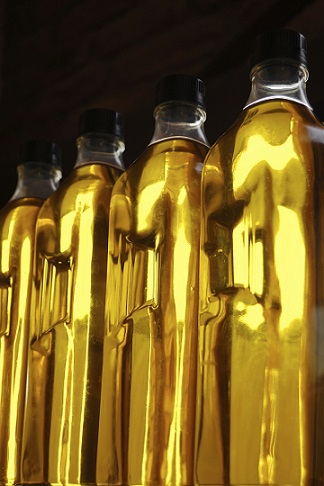 Dietary fat is easily the most controversial macronutrient of all time. Firstly, you have the “fat makes you fat” crew, who believe that all fat instantly enters your bloodstream and slowly clogs your arteries (it doesn’t).
Dietary fat is easily the most controversial macronutrient of all time. Firstly, you have the “fat makes you fat” crew, who believe that all fat instantly enters your bloodstream and slowly clogs your arteries (it doesn’t).
Then you have the never-ending wars over specific types of fat. The USDA, British NHS, World Health Organisation and American Heart Foundation all insist that saturated fats in butter, meat, and chocolate increase cholesterol levels and can and will lead to heart disease. The Paleo/Primal community argue that polyunsaturated fats (soybean oil, corn oil, sunflower oil) oxidise inside your body and are giving everyone cancer.
This debate still continues today, but inbetween, there’s one fat that everybody loves – extra virgin olive oil. The reasoning is simple. Olive oil is a monounsaturated fat, a fat that neither raises “bad” LDL cholesterol nor is unstable enough to oxidise.
Olive oil is totally uncontroversial. Better, it’s probably the most nutritious cooking oil of all time, including for a variety of acne nutrients.
Olive oil is cold-pressed and contaminant free
One excellent thing about olive oil is that because its history is so extensive, we’ve accumulated thousands of years worth of expertise in naturally cold-pressing it.
Olive oil was first mentioned in history back in 6000BC. The regular olive oil trade originated in the ancient city of Aleppo (unfortunately now the scene of heavy fighting in the Syrian civil war) back in 2500BC.
Olive oil wasn’t just a food; ancient Egyptians used it for medicines, fuel for oil lamps, religious ceremonies and soap making. Remnants have been found in jugs over 4000 years old. The first recorded olive oil extraction took place in Ancient Egypt back in 1500BC. Ancient Egyptians simply squeezed the olive berry by hand and stored it in special containers. Many Roman Empire olive oil mills are still standing in the Mediterranean, and incredibly, some are still in use today.
Read Annihilate Your Acne – learn how to clear your skin permanently
Then there’s canola oil. Also known as rapeseed oil, it’s touted as being a heart healthy choice for salads since it mostly contains monounsaturated fats. But the rapeseed plant also contains a natural toxin called erucic acid which is poisonous to humans. Canola oil in its natural state would actually be deep red, not clear. Canola oil only became available to humanity during the last 100 years when the required industrial technology was invented.
So what you end up with is two oils that are very different for acne:
Extra virgin olive oil – cold pressed using basic machinery. Sometimes lightly filtered to remove bitter remnants of the olive fruit. Retains all the acne friendly tannins, vitamin E, phenolic compounds, and other antioxidants.
Canola oil – commonly contains traces of a neurotoxic solvent hexane, used to separate the canola protein cakes from the oil. Swimming with free radicals thanks to scorching heat in the factory oxidising the fat molecules. The same industrial heating may mutate the fats into acne-causing trans-fats. The antioxidants are all obliterated due to their fragility. Its vitamin E is useless since the oil is so rancid.
Assuming it’s cold-pressed and extra virgin, olive oil is by far the cleanest cooking oil an acne patient could use (alongside coconut oil).
Packed with the greatest acne vitamin
Olive oil is also a particularly nutritious oil. In fact, it’s one of the best sources of acne-clearing vitamin E available. 50 grams contains 36% (6mg) of the recommended daily intake.
If, for example, you add plenty of olive oil to your salad each day, cook potatoes in it, and drizzle it onto meat to enhance the flavour, that’s a ton of vitamin E right there. Vitamin E isn’t the most common nutrient either. Broccoli is claimed to be a great source, but 100 steamed grams contains only 4% of the RDI. Spinach contains 10% per 100 grams.
If you haven’t read this article yet, then vitamin E is the main antioxidant used to stabilise the squalene in your skin’s oil. If this squalene reacts with free radicals in air pollution or cigarette smoke, it mutates into pore-clogging squalene peroxide, which increases both sebum (oil) production and dead skin cell turnover.
Recommended – 6 vitamins and minerals which could finally clear your acne
It’s critical for all acne patients to eat more vitamin E, and eating olive oil in a variety of imaginative recipes is one solution. Additionally, this study found that the phenolic antioxidants in olive oil protect your existing vitamin E from being depleted. The best source of vitamin E in the world is almonds (131% per 100 grams) so if you dip your almonds in a bowl of olive oil, it’ll basically be game over for your acne.
Olive oil is also a great source of other antioxidants. Its ORAC score of 372 is merely decent, but actual studies generally outstrip this. This and this study declared that the oleuropein and hydroxytyrosol in olive oil were such powerful antioxidants that they might prevent cancer.
This study found that olive oil increased the self-manufactured antioxidant glutathione, through an unknown mechanism. The bitter flavour of unfiltered olive oil is partly from its abundant antioxidants like oleuropein, and most likely other undiscovered compounds.
Olive oil is an overlooked prebiotic
Olive oil is also a little known prebiotic powerhouse. It’s estimated that the skin of a Gordal variety olive fruit contains 100 billion lactobacilli bacteria, and tests have proven that they migrate to the oil. Their final destination is your gut.
As we often discuss here, gut bacteria diversity is a seriously underestimated player in acne. For example, good strains can enhance acne nutrient digestion, while some malicious strains pump out the stress hormone cortisol, regardless of whether you’re actually stressed.
Many traditional Spanish and French olive oils are fermented to add extra flavour, which multiplies the healthy lactobacilli even further. Some olive oil antioxidants, namely oleuropein, hydroxytyrosol, and tyrosol, can fuel the bacteria already in your gut…
…and this study on Portuguese olives found that olive oil could also kill unhealthy strains, namely h.pylori. In as little as two weeks, 30 grams killed h.pylori infestations in 10-40% of patients.
H.pylori overgrowth is a very common cause of inflammation and digestive infections. It also damages the semipermeable membrane of your gut lining and impairs the absorption of important acne nutrients, especially minerals like zinc and magnesium. This study found that h.pylori overgrowths were much more common in the stomachs’ of rosacea sufferers, a skin condition with similar inflammatory roots to acne.
7 natural topical treatments which can massively reduce acne
H-pylori also directly cripples friendly lactobacilli gut bacteria, and is linked to stomach ulcers. Therefore, it’s great news that olive oil can kill it. In fact olive oil’s prebiotic powers are now being investigated by the Spanish authorities, namely the CSIC.
Olive oil lowers inflammation
 There’s one compound in olive oil which scientists have investigated more than any other – oleocanthal.
There’s one compound in olive oil which scientists have investigated more than any other – oleocanthal.
For good reason too, because oleocanthal is an anti-inflammatory powerhouse. In this 2005 study, just 50ml (3.4 tablespoons) of extra virgin olive oil contained enough oleocanthal to match the anti-inflammatory properties of 10% concentration ibuprofen.
This 2011 study was nearly identical. Oleocanthal inhibits the powerful cyclogenase-2 (COX-2), an especially useful molecule to downregulate since it activates dozens of smaller pro-inflammatory chemicals.
If you’re unaware, then chronic inflammation is the biggest disease any acne patient needs to tackle. Inflammatory processes are necessary to survive, but overactive ones lead to red, swollen pores, and hence acne. This study found that eating olive oil inhibited inflammation at the genetic level.
Furthermore, olive oil is 100% fat, and 72% of that fat comes as oleic acid. This Japanese study on 1,556 men and 1,461 women aged 35-60 found that eating more oleic acid led to a big drop in bloodstream C – reactive protein (CRP), the most commonly used biomarker of inflammation levels. This study found that oleic acid decreased both CRP and the acne-causing inflammatory chemical interleukin-6.
Olive oil – not just a skin saviour
What’s better is that extra virgin olive oil has been shown to prevent almost every major disease plaguing Western civilisation today. Conventional wisdom states that dietary fat is a cardiovascular nightmare since it remorselessly clogs your arteries. But olive oil is probably one of the best studied heart-protecting foods of all time.
ONE: in this study, olive oil was demonstrated to protect LDL cholesterol from oxidative damage. Oxidised LDL, rather than intact cholesterol, is what attracts to arterial walls and accumulates there, causing a clogged artery.
TWO: in this study, olive oil decreased both systolic and diastolic blood pressure among hypertensive people. Furthermore, it nearly halved the need for blood pressure medication.
THREE: in this study and this study, olive oil improved the function of the endolethium, one of the linings of your blood vessels, a classic risk factor for cardiovascular disease.
FOUR: two studies have demonstrated that olive oil prevents blood clotting, which is clearly heart-healthy as it encourages proper blood flow.
There’s probably over two hundred studies showing that olive oil protects the heart.
Then there’s the promising Alzheimer’s disease benefits. One of the biggest changes observed in the brain cells of Alzheimer’s patients is a build-up in so-called beta amyloid plaques. This mouse study found that the anti-inflammatory compound oleocanthal can effectively remove those plaques. This study found that a Mediterranean style diet rich in olive oil enhanced overall brain function.
Watch out for olive oil fraudsters!
As with any great tasting superfood, an army of cheap hustlers has sprung up to take advantage of the internet hype.
Extra virgin olive oil is the standard, since it’s cold-pressed and retains the healthy antioxidants. But you need to be streetwise, because countless extra virgin brands on the market are nothing of the sort. Big manufacturers and small time merchants alike are known to splice or “enrich” their olive oils with cheap rapeseed oil (which causes acne by increasing inflammation).
Primarily, they do this to save money. The extra virgin olive oil trade is worth $1.5 billion a year in the US, but it’s estimated that 70% on the market is fake. In Italy, they often add chlorophyll to cheap soybean oil to give it a similar flavour. The Sicilian Mafia makes millions each year by selling imitation olive oil, money which then gets funnelled into buying armaments. Often the olive oil portion is not cold-pressed; instead it’s extracted like any other vegetable oil with solvents called hexyls.
So firstly, you should never buy regular “olive oil” from the shops, because this is nearly guaranteed to be spliced and diced. Secondly, get your extra virgin olive oil from a reputable source. Organic certified is ideal if you can afford it.
For some interesting reason, dark glass bottles are more likely to be legitimate. This also improves the nutritional quality, since it blocks sunlight from entering and oxidising the fats into free radicals (a nightmare for oily skin and acne).
The neverending cooking oil myth
 On the other hand, there’s one scare story that’s a complete myth. Olive oil is an excellent cooking oil. It’s believed by many paleo enthusiasts that frying olive oil oxidises some of the fats. It’s true that monounsaturated fats are less stable than saturated, but they beat the polyunsaturated fats of soybean and corn oil with ease. Studies show that frying olive oil fails to increase free radicals in the resulting meal.
On the other hand, there’s one scare story that’s a complete myth. Olive oil is an excellent cooking oil. It’s believed by many paleo enthusiasts that frying olive oil oxidises some of the fats. It’s true that monounsaturated fats are less stable than saturated, but they beat the polyunsaturated fats of soybean and corn oil with ease. Studies show that frying olive oil fails to increase free radicals in the resulting meal.
ONE: scientists heated extra virgin olive oil to 180 degrees Celsius (356F) for 36 hours, and the oil was highly resistant to oxidation (study).
TWO: scientists used olive oil for deep frying, and the oxidative damage only reached dangerous levels after 24-27 hours (study).
Another common claim is that heating olive oil to moderate temperatures will degrade all the nutrients, but this is mostly false. This study found that heating olive oil at 464°F/240°C for 90 minutes reduced the oleocanthal by 19% according to a chemical test, and by 31% according to a taste test. This study found that heating at 356°F/180°C decreased both the antioxidants and vitamin E after 36 hours.
Many paleo followers are using the information above to discredit olive oil. For reasons I cannot understand, a lot of people in the primal community hate olive oil.
However, if you kept your eyes open, you’ll have noticed that the cooking conditions were extreme and totally unlikely to be replicated. In the real world, nobody would ever cook with olive oil for 36 hours. You’d probably never approach 90 minutes either.
Almost any acne-friendly food would be ruined in that situation. The vitamin C in broccoli gets depleted by 50% after just 10 minutes of boiling. Olive oil is far more stable than that, so don’t worry about frying a steak in it.
Conclusion
Olive oil is easily the most acne-friendly oil to dress a salad with. It beats the supposedly healthy but actually deadly canola oil with ease.
Olive oil is even superior to coconut oil, whose main power is to accelerate weight loss by improving your metabolism with its medium chain triglycerides (MTCs). That’s a cool power, but only helps acne very indirectly. With olive oil, you can pummel your pimples with reduced inflammation, replenished antioxidant stocks, and enhanced bacteria gut flora.
A simple strategy I use every two days is to cut some potatoes into wedges, coat them in extra virgin olive oil, and cook them in the oven for 35 minutes. But that’s just one way to acquire this flexible, acne-clearing oil.
NEXT: forget creams and moisturisers – discover the ultimate acne-clearing diet
Thanks for reading!

It’s good to know that, “Olive oil is fantastic for acne and furthermore it’s one of the healthiest food ever for you heart.” I never realized that it could be so beneficial! I like your potato wedges idea, I’ll have to see if my wife would want to do that for dinner tonight. Thanks for sharing!
Thanks Jack. You’re going to love it, it’s a simple but delicious recipe in my opinion. The more olive oil the merrier. 35-40 minutes on 190 centigrade does the trick.
Thank you for this fantastic article. I have recently been changing my diet to a more mediterrenian style including lots more vegetables, beans, seafood, and lean meat. I try to eat a lot less meat then i used to. So i have been doing this for about a week now and i already feel better, my skin is slowly improving (i have some reocurring acne) and also i eat a lot of extra virgin olive oil, like maybe 4 or more spoonfulls a day. I maynly do this for the health of my skin and to feel good in my body overall. Greetings from cold Norway :D
Hi, love your article; but find it too good to be true. Will olive oil get rid of forehead cysts? I am so sick and tired of trying out new fads; hope to you hear from you soon. P.S. How long will I have to wait to see the results,
Thanks.
This article is NOT saying that olive oil will clear your acne completely. There’s many other strategies for acne, this is just an analysis of an individual food. You need multiple acne-friendly foods to put acne to an end.
Does olive oil affect the ever important Omega 3-6 Ratio? The ratio makes or breaks me :P
Olive oil does affect the omega 6 ratio, and the ratio itself is diabolical (11:1, 6 to 3), but because olive oil consists of 75% monounsaturated fats, and very little polyunsaturated fat, at 10%, it will have very little effect on your diet’s overall ratio. Olive oil = safe.
Great, in your fantastic book you mention its importance (Omega Ratio).
How important do you rate it?
Could u please advice me a the best way to get red of my acne I used almost all kind of chemical drugs but they just hurt me,my doctor told me I don’t have hormons problem also my sonography was pco but he gave me just vitamin e and it was’t enough for my acne☹
Buy the book Sara. Its the best information on acne to date.
It’s one of the most important actors contributing towards chronic inflammation, particularly in the wider population where everybody eats vegetable oils like there’s no tomorrow, and since chronic inflammation is the joint biggest cause of acne, that makes it extremely important. The sources of omega 6s also have their own problems, like vegetable oils and their free radicals. That said, don’t get too harsh on omega 6s, since certain sources like nuts and avocados have benefits for acne, with olive oil itself being a good example.